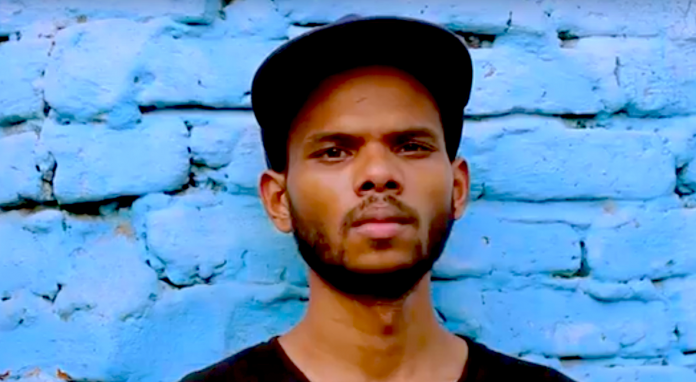By Siddhant Mohan, TwoCircles.net
The list of atrocities against marginalised communities in India can make for a small book, but the forms of resistance against these gruesome acts have, until now, mostly been enacted through literature and sometimes songs and theatre. Now, rap is being introduced into the resistance by Sumeet Samos, a 24-year-old postgraduate student from Jawaharlal Nehru University (JNU). For him, rap is the most effective weapon to fight casteism and to develop a powerful anti-caste narrative.
Associated with Birsa Ambedkar Phule Students Association (BAPSA), Samos sees Rap as the medium of his storytelling. Belonging to the Schedule Caste category, Samos witnessed caste discrimination and alienation at every level of his life.
Talking about his various experiences, Samos told TwoCircles.net, “Because of my background, I was always labelled as a criminal since my childhood. And the discrimination against me reflected from the same perception of my life. And not just mine, people from Dalit communities have been facing this for thousands of years.”
For Sumeet, the art of rap is the best medium of expression, and this has developed after passing through different popular mediums of expression. “My idea is simple.. reach out to a big mass of audience. And this determination came with whatever social and political understanding I developed since my childhood,” says Samos. “I watched black hip-hop artists, and I watched them a lot. As I was writing on anti-caste issues, I found there was a rhythm in those texts, not literal but practical, one just had to polish and address through that,” he adds.
By “rhythm”, Sumeet Samos refers to a trend and pattern in the caste violence discrimination and caste-targeted violence incidents were happening in the country. Be it Laxmanpur, Bathani Tola or Una and Mirchpur, Samos’ verses are trying to cover it all through rapping.
Samos’ first official rap video “Ladai Seekh Le” will be released later this week, but the trailer, released by Qweed Media, is already gaining attention, share and thousands of views on social media platforms.
With the lines such as: “Aadhi Raat Azaadi Foonkati Chhappar Teri Bastiyon Mein” (At midnight, the freedom burns down the huts in our neighborhood), Samos tries to narrate, figuratively, what happened in Laxmanpur Bathe, Bihar in 1997 when Ranvir Sena killed 58 Dalits at midnight.
He says, “If I have to know the essence of existence, I just have to look at the attack and abuse the community has been facing. It is that simple and clear.” He further says, “The idea of existence can only exist with our destruction and that is what I have tried to mention here.”
In the same rap, Samos mentions Antonio Gramsci—the Italian Marxist philosopher—through Gramsci’s debate on traditional versus organic intellectuals, by saying, “Padhe Ho jo Kitaabon Mein Hum Har Roz Usko Jeete, Asaliyat Mein Gyan kya hai Humse Ye Seekh Le (What you are reading in books, we live that every day. What is actual knowledge, learn it from us.)”
Samos’ first official rap video talks while appealing to live through resistance and to learn to fight. At one point, lyrics said, “Maang-Maang Ke Thak Gaye, Ab Sab Kuchh Lenge Chheen Ke (We are tired by begging, now we will snatch everything which is supposed to be ours).”
Samos comes from Tentulipadar, a village in Koraput district, Odisha. He has seen caste atrocities since birth, and the area itself is affected by Maoist insurgency and hence the Army’s actions as well. And Samos’ childhood involvement in the village theatre has helped him to get a hold of rapping in practice. “My training in theatre basically helped me to talk in rhythm for minutes on end without any break and without the use of any kind of notes or papers,” says Samos.
For Samos, using an artistic method to express is powerful because of two basic reasons. One, it reaches masses more easily than speeches or articles, and two, it creates consciousness in the minds of the people.
Adopting rap as a medium to express was also a result of an internal conflict of Samos. “I have been seeing boys from Dharavi or Nala Sopara — slum dominated localities of Maharashtra —rapping over various things. They have been rapping on power, politics, and corruption in the system. They were addressing their very local problems,” says Sumeet.
“But I wonder why the matter of caste and class did not come up in their raps. This thing also drove to go ahead to produce my kind of art,” says Samos.
He says, “People are either too privileged or they do not want to talk about caste and associated problems. Maybe that is the reason artists have been refraining from touching these issues.”
At a time when “Daaru-Gaadi-Ladki (Booze-Cars-Girls)” kind of rap is prevailing in the country in the Indian Cinema and Music platforms, Samos has to fight an artistic battle to reach out to a cause. He says, “The kind of rap people are enjoying here does not address the class or caste we are talking about here. Dalits do not have cars, they do not have access to sparkling liquor or top-notch alcohol. They drink cheap country-made liquor and go home to their wives where, many times, they beat them. So modern-day raps are kind of Utopia for Dalits of this country.”
“But I am just beginning. My words wouldn’t be entertained by production houses, because there is no “glamour” in there. But I depend on people’s love, my fellows, and social media for my buildup,” said Samos. “I hope I get my break soon, so I could reach to more people.” After all, he raps, “Rapperon Ki Bheed Mein Apna Naya Scene Hai (My scene is a bit new in this crowd of rappers).”
https://www.youtube.com/watch?v=HL1-C10T6zA


